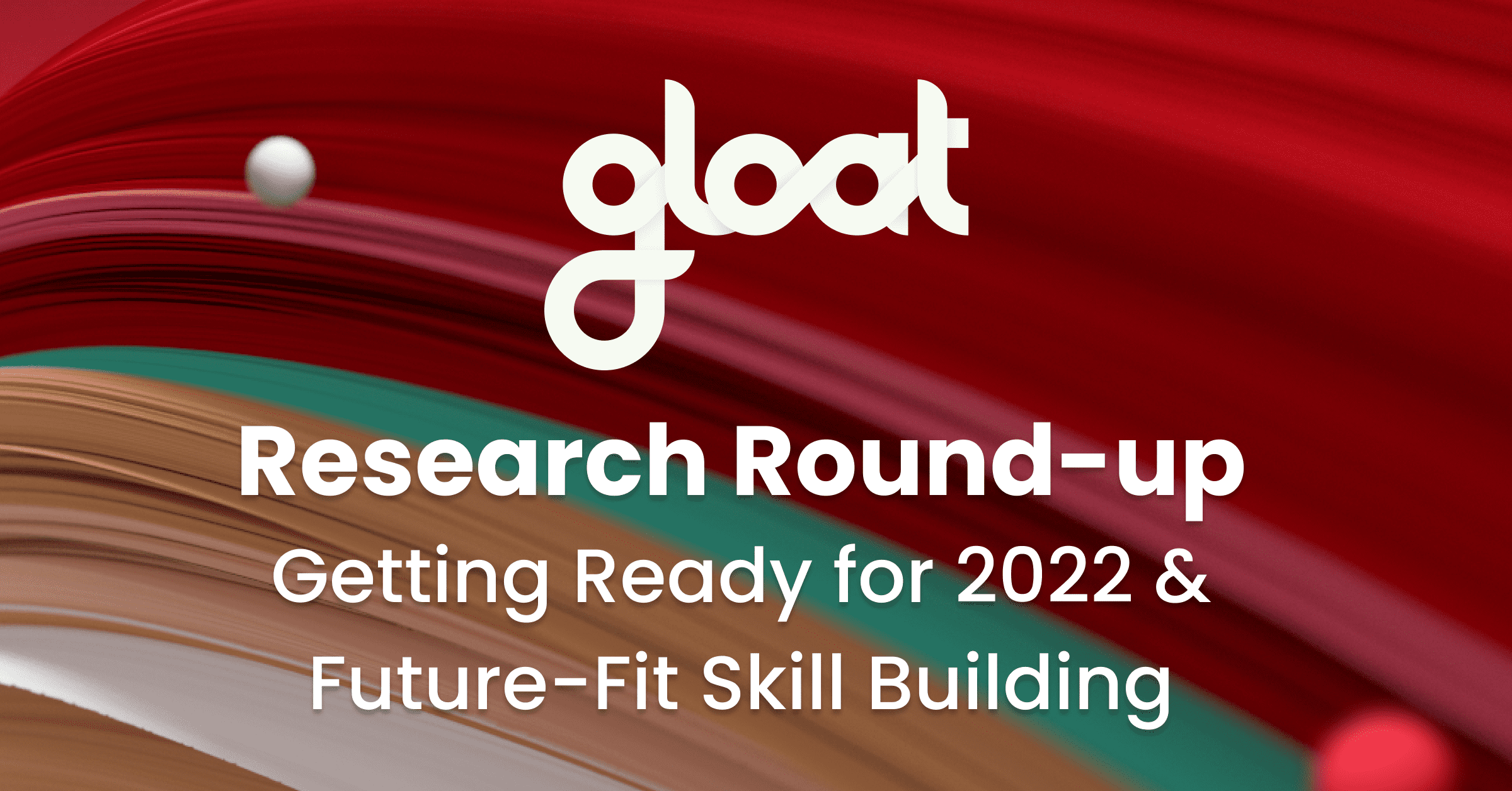October research round-up
What I’m Reading, Listening to, and Thinking About in the World of Talent Marketplaces -- Getting Ready for 2022 and Future-Fit Skill Building

Right now, it’s safe to say that HR and people leaders have their plates full. The Great Resignation (aka as the Great Reassessment and the Great Reshuffling) is accelerating. Work models are being recalibrated to not only address diversity, equity and inclusion, but to advance it. And nearly three-quarters of organizations are embarking on workforce transformations.
Since there are so many high-stakes items on HR’s agenda, how can we decide what earns a spot at the top of our list? I’d argue that right now we need to focus our attention on two issues. First, leaders of the people agenda must work on formulating a clear view of their priorities for 2022 and beyond. In many ways, the 2020s start now; 2022 is the first year which will hopefully not be dominated by COVID-19, but by our goals, aspirations, and strategic priorities. This is a theme I will be exploring over the next couple of months but I’m introducing now.
Second, we need to set our sights on skill building because it has the potential to impact most, if not all, of the crises and crossroads that people leaders are facing today. How can you demonstrate that your organization is the best place for employees to grow, explore and develop their careers? How can we give employees real agency and choice to try new experiences and the chance to learn new things that are relevant and in-demand in our company? What does it take to level the playing field? Equipping everyone with access to upskilling and reskilling is certainly a step in the right direction. And what about fueling successful workforce transformations? One of the central challenges is understanding the skills we have, the skills we need, how to help our employees access and build skills to pursue their goals and career ambitions — hopefully INSIDE our company– and how do we build the skills in our workforce that our business and team leaders need for today’s and tomorrow’s business challenges.
Ultimately, an organization may only be as good as the sum of its peoples’ skills, experiences, and interests and its organizational capability to understand these skills and interests and make better and more timely talent decisions. But like every other element of the working world, the conversation around upskilling and reskilling is evolving rapidly. One-size-fits-all curricula curated by leadership are out; employee-driven growth opportunities that blend experience, content and hands-on learning are in. And leaders are finally getting the full picture into the capabilities within their workforce, so they can bridge existing skills gaps and ensure their organizations are prepared for the future of work.
We’re only at the opening chapter of this new approach to building skills and transforming workforce planning. However, many of the leading voices in HR and people management already have quite a few things to say. Since there are plenty of important insights to share, I am dedicating this month’s Research Roundup to exploring the idea of future-fit skill building and pinpointing how these efforts can set us up for success in the new world of work.
The focus of this month’s round-up is the skills and re-skilling agenda.
But first, I want to introduce, as mentioned above, the elephant in the room: How do we reframe our people management priorities and future of work agenda as we plan for 2022, the first year in the 2020s which will not be dominated by COVID-19? I have a lot to say about this topic and it’s one I’ll be discussing at Gloat Live on December 1 and 2 as I explore “the Future History of the Talent Marketplace.” But first, I’d suggest these two podcasts to kick off your thinking:
Planning for the Post-COVID People Management Challenges
Leadership Styles Must Adapt to Prevent More Quitting, The McKinsey Podcast, with Aaron De Smet and Bill Schaninger
This provocative conversation is a call to arms building on a theme I explore in detail in my book, WORK DISRUPTED. In short, the world has and is changing as the shifts uncovered during the COVID era have made the concerns, perspectives, and desires of the workforce more visible. These are the drivers of the Great Resignation and the Great Reassessment. In this podcast, we are challenged to think about how and what leadership practices need to evolve to keep pace. Listen to it and discuss how your colleagues and teams should upgrade your approach accordingly.
Flow of Work Applications Have Arrived, Josh Bersin Academy Podcast, with Josh Bersin
In this podcast, Josh highlights a trend we’ve been tracking for several years: how HR and talent applications are being integrated into the flow of work (and life) through connections to our virtual workplaces. Think Microsoft Teams, Google Workspace, Slack etc. This shift is critical as HR and talent partner with business and functional leaders to integrate career growth, opportunity for new experiences, learning, and fundamental HR transactions and compliance into our virtual workspaces– not as separate apps, but as real-time nudges and notifications. For me, this podcast prompts us to think about how we integrate and make career, learning, and HR part of our work and life flow and not separate tools and apps. In the 2020s, this integration and customer user perspective will be critical.
And here are the pieces of content I think leaders need to have on their radar if they want to get upskilling and reskilling right:
READ: What’s new in thought leadership about the future of work
What Motivates Lifelong Learners, Harvard Business Review, by John Hagel III
I have known John for more than a decade as the former co-chair of Deloitte’s Center for the Edge. A leading thinker in strategy and people management, he’s the author of a great new book, The Journey Beyond Fear. Given the rapid pace of technological and strategic change that’s all around us, it’s very clear that our workforces are going to need what John describes as the “passion of the explorer.” But how can we make upskilling and reskilling feel less like an obligation, less likely to be motivated by fear, and more like an exciting opportunity? John believes that businesses need to step away from models of scalable efficiency and focus on redesigning work practices to cultivate a sense of passion and exploration.
Getting Skills Transformations Right: The Nine Ingredient Recipe for Success, McKinsey, by Aaron de Smet, Angelika Reich, and Bill Schaninger
Most companies know the need for new skills is urgent and nearly 70% have been doubling down on upskilling since the pandemic’s onset. However, large-scale skill building initiatives are proving difficult to get right. Rather than just one key to success, McKinsey’s article suggests that there are actually nine best practices that leaders should keep in mind when launching upskilling and reskilling initiatives. Key action points include assessing potential skills gaps, developing a skills strategy with tailored learning journeys and delivery plans, and reimagining infrastructure for skill building at scale.
As The Great Resignation Accelerates, Execs Scramble to Address the Labor Shortage, TechRepublic, by Esther Shein
TechRepublic’s write-up is filled with eye-opening statistics about the state of talent mobility and hiring today. Of particular note is the fact that 71% of hiring managers with open positions say that they are receiving applications from workers who lack the skills needed to fill those positions. At the same time, one third of employees report that their manager has never identified the skills they need to learn, highlighting a major lack of transparency that businesses are going to need to address as they revamp their approach to learning and upskilling.
Horizontal Ignition is Needed Now More Than Ever, Forbes, by Dan Pontefract
Employees aren’t just leaving for something better; in August, more than 800,000 people quit their jobs and remained unemployed in September. What does that number tell us? Nearly one million people aren’t interested in taking the next step up on their predictable career ladder. Traditional, vertical ambition has given way to what Pontefract calls “horizontal ignition”– the idea that a large percentage of employees want to take on lateral learning, increase skill development, and exchange expertise with new peer networks. The sooner business leaders recognize and understand horizontal ignition, the sooner they will be able to develop skill building initiatives that meet their people where they are at.
CEOs: What You Need to Know About How Your HR Team is Feeling, Fast Company, by Lars Schmidt
If the Great Resignation and the challenges of architecting a successful return to work initiative have left you with your own sense of burnout, you’re not alone. This Fast Company article discusses one impact of today’s ongoing labor shortage that’s often overlooked: people leaders are starting to feel the pressure, as evidenced by an 87% spike in the number of HR job postings since February of last year. In addition to exploring the contributing factors, this piece pinpoints some of the steps CEOs can take to help people management teams out, including investing more in HR initiatives like growth and development, so that leaders are no longer expected to do more with less.
LISTEN: What I’ve been playing on repeat
Management for the Recovery: Firm Resilience, Public Sector, and Technology, Capitalism After Coronavirus, with Raffaella Sadun
Capitalism after Coronavirus is dedicated to exploring how the pandemic has changed and will continue to change the working world as we know it. In this episode Raffaella Sadun, a Professor of Business Administration at Harvard Business School, discusses the actions that resilient companies took against COVID-19, health, education, and public sector management. She also sheds light on some of the technological changes firms have made and how these innovations will shape their plans for recovery. If you’re looking to contextualize the changes your organization made in the midst of the pandemic and harness these insights to inform future-fit skill building strategies, think of this as required listening.
THINK: What research and studies are saying about our path forward
Self Compassion Helps Leaders– And Their Workers, University of Michigan Ross School of Business News, by Bob Needham
As the Great Resignation continues, many leaders are concerned about retention, and some stakeholders might even start to view upticks in turnover as a personal failure. While some sense of disappointment is inevitable, research from the University of Michigan highlights why leaders need to maintain a sense of self compassion. Professor Sue Ashford found that when leaders engaged in a self compassion exercise, they offered more help to their employees and their workforce perceived them as more civil and competent, making the approach a win-win.
ICYMI: What I keep coming back to
Why Everybody’s Hiring But No One is Getting Hired, Vox, by Rani Molla and Emily Stewart
The title of this Vox article gets right to the heart of what we’re seeing today: every business is looking for talent, but few organizations are getting their hands on the people they need. What accounts for this discrepancy? Once again, skills are a big part of the equation, since many applicants don’t have the capabilities that employers say they’re looking for. Rather than relying on technology that is designed to count people out, leaders need platforms that will count internal candidates in, and the talent marketplace is a prime example of that.
CONNECT: What future-fit organizations and leaders are talking about
Thinking About Quitting? Become Your Own Boss First, Linkedin, by Dave Evans
While many unsatisfied employees think quitting is their best option, Dave Evans, the co-Founder of Stanford’s Life Design Lab, explains why that isn’t always the case. He names four strategies employees can use to redesign their jobs, including “Reframe and Re-enlist”, in which he encourages all of us to take a greater sense of ownership of our own professional development. The piece includes a handful of questions employees need to ask themselves when contemplating a big move, including re-evaluating what skills are more or less important than they were in the past.
World’s Best Employers 2021, Forbes, by Sarah Todd
Much like hands-on learning complements L&D curriculums, leaders can benefit from not just reading about best practices for upskilling and talent mobility, but also seeing them in action. Forbes’ list of the World’s Best Employers in 2021 gives managers a glimpse into some of the innovative approaches that are setting future-fit enterprises apart. I’m particularly excited to see three of our friends who are leveraging Gloat’s talent marketplaces make the list: PepsiCo, Novartis, and Metlife.
Let us know what you would add to our list.





